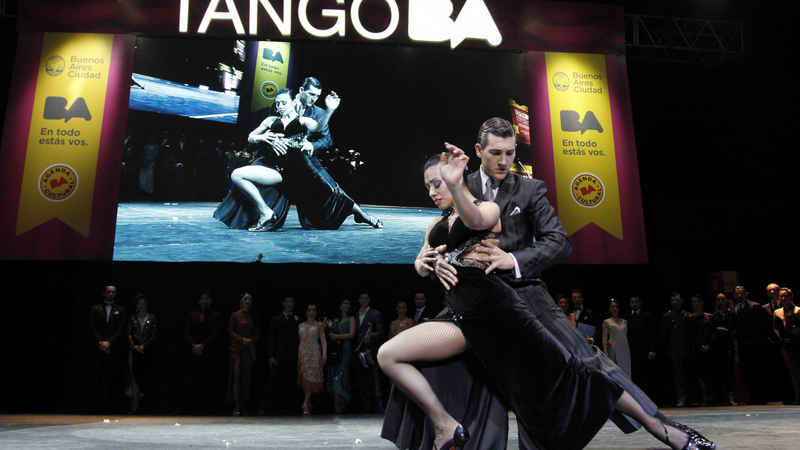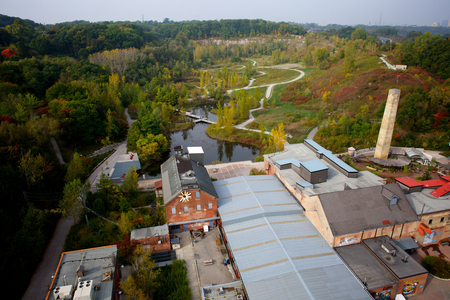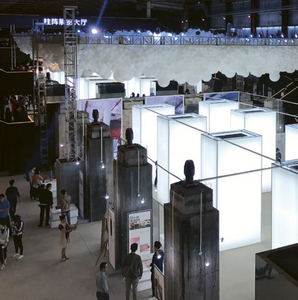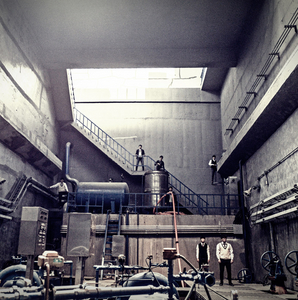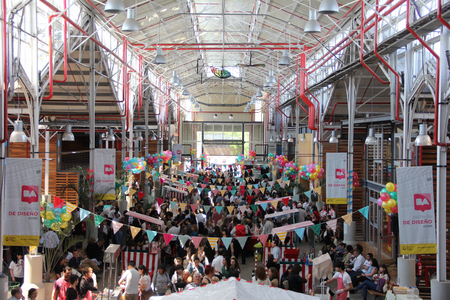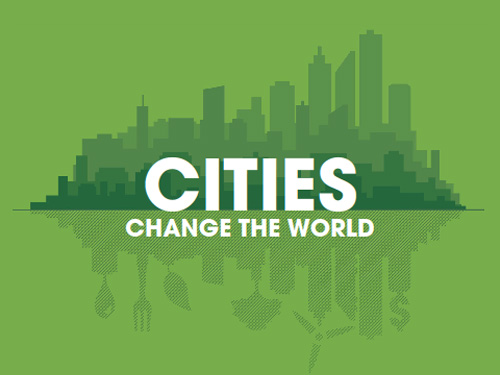Culture is a crucial dimension of urban redevelopment projects in metropolitan areas. Widely seen as a way to revive neighbourhoods suffering from deindustrialization, it has also become a major factor of attractiveness for executives and large companies, sometimes at the expense of accessible housing and workspace for artists as well as residents.
The rise of the knowledge economy, the growth of cultural and urban tourism and the emergence of “creative industries”, not to mention the new emphasis on culture as a means of attracting business: all these recent developments have led to a new focus on the place of culture in urban development. Culture is seen as stimulating long-term economic and social growth in cities by shaping a sense of place and social space that increases the city’s attractiveness to an educated workforce and the businesses which seek to employ them. Culture has been associated with urban regeneration since the 1990s, especially in post-industrial cities. Artists and cultural professionals, attracted by cheap rents and inner city living, are often among the first to move into neglected districts and turn urban “no go” areas into dynamic and fashionable places to live and work. A growing number of cities have instigated programs to attract creative businesses and cultural institutions to their deindustrialized neighbourhoods: strategy implemented with success by Buenos Aires for nearly 20 years.
The ‘thematic districts program’ of Buenos Aires
Argentina’s capital is an important cultural hub in Latin America and beyond. It boasts more theatres, bookshops and cultural spaces per capita than any other city in the world, besides numerous free events and festivals. The World Tango Festival & World Cup, the International Jazz Festival, the International Festival of Independent Cinema, and the International Book Fair attract hundreds of thousands of visitors every year. The government supports many training projects, incentives and competitions to encourage creativity, and sees arts policy as an important lever to promote greater social inclusion. The cultural and creative industries are a significant contributor to the city economy, but they have tended to cluster in specific areas leaving some parts of the city underserved. In recent years, the city has developed a policy that both capitalizes on its creative talents and uses planning to regenerate low-income or under-developed city neighbourhoods. The ‘thematic districts program’ uses tax incentives and subsidies to attract certain businesses to particular areas of the city. The policy focuses on sectors where the city already has an advantage – sectors which provide high value-added jobs and are good exporters. The program began in 2001 with the Design District in Barracas, an inner-city neighbourhood that vividly illustrates the bleak fate of former manufacturing neighbourhoods in a city undergoing deindustrialization: physical decay, degradation of its public infrastructures, disinvestment and the gradual impoverishment of its residents. A key objective of the project was urban revitalization and sustainability. At the heart of the project lay the conversion of a former fi sh market into a 14,500m2 Metropolitan Design Centre. The Centre now houses government offices that promote design, business in the creative industries and foreign trade. It also has 70 workspaces for nurturing entrepreneurial ventures, an auditorium, classrooms, spaces for workshops, laboratories, exhibitions and displays, a specialist library, a museum and a cultural centre. It regularly opens its doors to the community with expos and international design fairs, and offers free training courses for the unemployed in trades such as sewing and leather work. This initiative helped Buenos Aires win the designation of World City of Design in 2005. The District’s impact on both the design industry and the regeneration of Barracas also convinced Buenos Aires that creative clusters are a successful formula for regeneration and growth. The city has instigated three more clusters since 2008, focused on the audio-visual sector, information technologies, and arts. This last scheme, put in place in 2012, focuses on the visual and performing arts, as well as publishing. It intends to promote the art sector, develop infrastructure and increase access to cultural activities using numerous subsidies to entice businesses to the area. The district now has many cultural attractions such as Fundación Proa, Usina del Arte, the Museum of Modern Art, the Museum of Contemporary Art, art schools and other cultural institutions. The Usina del Arte is a good example of culture-led regeneration. Located in the heart of La Boca in the south of the city, the new facility inhabits the former home of an electricity company. Along with several halls and theatres, the building houses the city’s fi rst Symphony Hall. In developing the project, the city’s ministry of Culture collaborated with other departments to revitalize the wider area, making it safer and more accessible, and encouraging tourists to visit. Although the four industry clusters have had important economic impacts, the social impact in these areas has been just as strong. The clusters have generated better infrastructure and public transport, greater access to culture and creative industries employment, the restoration of other buildings in the area as businesses move in and need premises, increased training in the arts and creative disciplines, and general improvements in the quality of public space and security. The city government intends to continue its agenda of decentralizing culture by physically inserting it into areas of the city previously neglected, thereby increasing the quality of life and opportunities for disadvantaged communities.
Metropolitan cultural projects
Hong Kong / Arts Space Scheme: creating more affordable artist studios
Hong Kong has one of the highest population densities in the world, and equally high property prices, meaning that there is a severe shortage of affordable studio space for artists. Launched by the Hong Kong Arts Development Council (HKADC) in 2014, ADC Artspace is the first arts space project put forward in Hong Kong. It is housed in a private former industrial building in an industrial zone in Hong Kong Island South that is now a burgeoning cluster of galleries and arts spaces. The project is collaborative, depending on an agreement with a private landlord willing to accept below-market rent.
Toronto / Evergreen Brick Works, using the arts to engage citizens in matters of environmental sustainability
Evergreen Brick Works turned an abandoned industrial site into a pioneering community facility that explores how nature makes cities more liveable. It includes a 40 acre park and 15 heritage industrial buildings. The Canadian federal government recently announced further funding for Evergreen to help support the transformation of one of the main buildings into a venue for cultural programming. The revitalised heritage building will include artist studios and meeting spaces, as well as enhanced public art installations.
Shenzhen / I-FACTORY, from industrial factory to creative factory
Shenzhen’s rapid transformation into a megacity has meant a shortage of space for culture and the creative industries. I-FACTORY is a Cultural Creative Park in the port of She’kou that aims to become the birthplace of a new urban culture. It is housed in a reclaimed industrial heritage site, retaining massive concrete silos, chimneys and a machine hall. This unique historic building has become a public space. I-FACTORY is a pilot for the wider Industrial Design Port project which is revitalising former factories in the port area, and plays an important part of the development of the cultural and creative industries zone.
Seoul / Street Arts Creation Centre, Turning industrial heritage into a street arts centre
Seoul had a limited and regionally unbalanced cultural infrastructure, with a particular lack of workshops and rehearsal space for street arts. Artists in less popular genres face the most severe shortage of cultural infrastructure. Opened in 2015, the Seoul Street Arts Creation Center offers facilities, professional development and education programs for street arts and circus arts. It is housed a former Water Intake Station, preserving an important piece of industrial heritage. It is a project of the Seoul Metropolitan Government, with planning and operations delegated to the Seoul Foundation for Arts and Culture.
Vienna / F23.wir.fabriken, Developing cultural facilities in a new district
Vienna is growing rapidly – its population has increased by 11% in ten years. The outlying 23rd district of Vienna is the newest district in the city, created from 8 former villages. As a result it has no real centre. The space between the villages became an industrial area, but many factories have now shut down or relocated. The 23rd district lacks cultural facilities and needs to develop a community identity. F23 is taking a former factory and renovating it to become a cultural focal point for the district. In 18 months, over 40,000 people have already taken part in the temporary cultural projects hosted at the site. The project is an extremely collaborative one, involving IG F23 (a non-profit organization), multiple departments of the City of Vienna, municipal officials from the district where the centre is located, and various cultural projects and partners. So far, F23 has been very well received by the local community.
Former industrial sites: an opportunity for culture
Closed factories, disused hangars, empty warehouses… as world cities adapt to new economic realities, the long process of deindustrialisation leaves behind scores of empty buildings. Former industrial districts, facing the loss of traditional sources of employment and business, can easily descend into dereliction, with rising social problems for residents left behind - joblessness, poverty, delinquency… But these areas also provide local authorities with considerable opportunities for cultural activities, whether in terms of production or consumption. Since the 2000s, it has become commonplace for cities around the globe to turn former industrial sites into new arts and cultural facilities. As world cities need new, flexible forms of cultural infrastructure for the multimedia artworks of 21st century digital artists, repurposing empty factories and warehouses has become one of the most common strategies to host contemporary culture while preserving industrial heritage. The higher headroom, higher limit load and less restrictive physical layout of warehouse spaces also offer the most suitable “loft working” conditions for cultural and artistic production.
But the challenges for metropolitan areas remain numerous, a topic that is being analysed by the World Cities Culture Forum. Created in 2012, it includes today 38 member cities from all over the world, such as London, New York, Shanghai, Paris Region, Seoul, Sydney, Tokyo, Warsaw, etc. By bringing together their cultural expertise and knowledge, the participants have created a unique research and policy forum to address the role that culture plays in their cities, and to strengthen their policy responses to the challenges they face1. One of them is the growing shortage of space for cultural projects. Despite international recognition of their role in regenerating cities, the availability of large vacant industrial spaces for cultural production is increasingly threatened by global real estate market trends in metropolitan areas as landlords tend to convert warehouse spaces into more profitable residential uses. This erosion of industrial spaces, and thus of cultural production, has a severe impact on a city’s overall capacity for innovation and its economic dynamism. A healthy experimental cultural and creative scene provides fertile ground for new ideas to filter into other communities and sectors of the economy. A lack of affordable workspace precludes cities from nurturing the new, the radical and the provocative, potentially creating an urban environment that stifles innovation.
Matthieu Prin, World Cities Culture Forum,
Carine Camors, Socio-Economist and Odile Soulard, Economist, L’Institut Paris Region
1. The examples above are based on work carried out by the World Cities Culture Forum, of which L’Institut Paris Region is a founding member.
